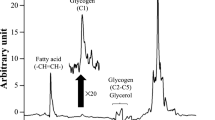Abstract
Four well-trained combination skiers were studied through pre- and post-training for the effects of short-term intermittent training during hypoxia on muscle energetics during submaximal exercise as measured by Phosphorus-31 nuclear magnetic resonance and maximal aerobic power (\(\dot V\)O2max). The hypoxia and training in the cold was conducted in a hypobaric chamber and comprised 60-min aerobic exercise (at an intensity equivalent to the blood lactate threshold), using a cycle ergometer or a treadmill twice a day for 4, consecutive days at 5°C, in conditions equivalent to an altitude of 2000 m (593 mm Hg). No change in \(\dot V\)O2max was observed over the training period, while in the muscle energetics during submaximal exercise, the values of phosphocreatine/(phosphocreatine + inorganic phosphate) and intracellular pH were found to be significantly increased by training during hypoxia. During recovery, the time constant of phosphocreatine was found to have been significantly reduced [pre, 27.9 (SD 6.7) s; post, 22.5 (SD 4.7) s, P < 0.01]. The observed inhibition of phosphocreatine as well as that of intracellular pH changes after training during hypoxia and quicker recovery of phosphocreatine in submaximal exercise tests, may indicate improved oxidative capacity (i.e. a high adenosine 5′-triphosphate formation rate) despite the short-term hypoxia training.
Similar content being viewed by others
References
Åstrand PO, Rodahl K (1986) Factors affecting performance In: Textbook of work physiology, 3 McGraw-Hill New York pp 684–723
Bender PR, Groves BM, McCullough RE, McCullough RG, Trad L, Young AJ, Cymerman A, Reeves JT (1989) Decreased exercise muscle lactate release following high altitude acclimatization. J Appl Physiol 67:1456–1462
Bigard AX, Brunet A, Guezennec CY, Monod H (1991) Skeletal muscle changes after endurance training at high altitude. J Appl Physiol 71:2114–2121
Chance B, Leigh JS, Kent J, McCully K (1986) Metabolic control principles and 31P NMR. Fed Proc 45:2915–2920
Constable SH, Favier RJ, McLane JA, Fell RD, Chen M, Holloszy JO (1987) Energy metabolism in contracting rat skeletal muscle: adaptation to exercise training. Am J Physiol 253:C316-C322
Green HJ, Sutton J, Young P, Cymerman A, Houston CS (1989a) Operation Everest II: muscle energetics during maximal exhaustive exercise. J App] Physiol 66:142–150
Green HJ, Sutton JR, Cymerman A, Young PM, Houston CS (1989b) Operation Everest II: adaptations in human skeletal muscle. J Appl Physiol 66:2454–2461
Itoh K, Moritani T, Ishida K, Hirofuji C, Taguchi S, Itoh M (1990) Hypoxia-induced fibre type transformation in rat hindlimb muscles: histochemical and electro-mechanical changes. Eur J Appl Physiol 60:331–336
Kuno S, Itai Y (1992) Muscle energetics during exercise by 31P NMR. Ann Physiol Anthropol 11:313–318
Kuno S, Akisada M, Anno I, Niitsu M, Itai Y, Katsuta S (1991) Heterogeneity of muscle energetics in human muscle fiber type using 31P NMR. Clin J Sports Med 1:247–250
Kuno S, Akisada M, Mitsumori F (1992) 31P NMR study on the effects of endurance training in rat skeletal muscle. Eur J Appl Physiol 65:197–201
Matheson GO, Allen PS, Ellinger DC, Hanstock CC, Gheorghiu D, Mckenzie DC, Stanley C, Parkhouse WS, Hochachka PW (1991) Skeletal muscle metabolism and work capacity: a 31P-NMR study of Andean natives and lowlanders. J Appl Physiol 70:1963–1976
Mizuno M, Juel C, Bro-Rasmussen T, Mygind E, Schibye B, Rasmussen B, Saltin B (1990) Limb skeletal muscle adaptation in athletes after training at altitude. J Appl Physiol 68:496–502
Taylor DJ, Bore PJ, Styles P, Gadian DG, Radda GK (1983) Bioenergetics of intact human muscle. A 31P nuclear magnetic resonance study. Mol Biol Med 1:77–94
Terrados N, Melichna NJ, Sylven C, Jansson E, Kaijser L (1988) Effects of training at simulated altitude on performance and muscle metabolic capacity in competitive road cyclists. Eur J Appl Physiol 57:203–209
Young AJ, Evans WJ, Cymerman A, Pandolf KB, Kanapik JJ, Maher JT (1982) Sparing effect of chronic high-altitude exposure on muscle glycogen utilization. J Appl Physiol 52:857–862
Author information
Authors and Affiliations
Additional information
Present address: Department Life Sciences, Univ. of Tokyo, Komaba 3-8-1, Meguro-ku 153, Japan
Rights and permissions
About this article
Cite this article
Kuno, Sy., Inaki, M., Tanaka, K. et al. Muscle energetics in short-term training during hypoxia in elite combination skiers. Eur J Appl Physiol 69, 301–304 (1994). https://doi.org/10.1007/BF00392034
Accepted:
Issue Date:
DOI: https://doi.org/10.1007/BF00392034




